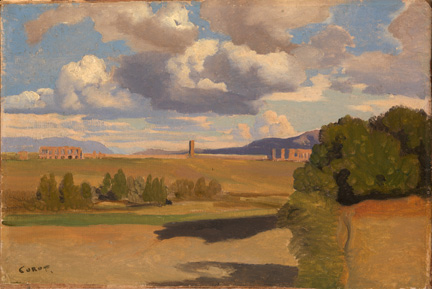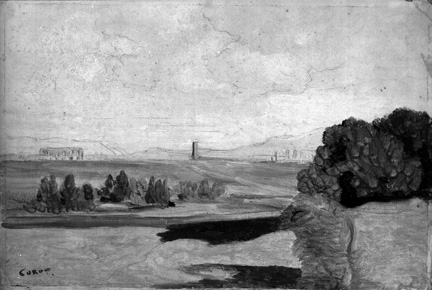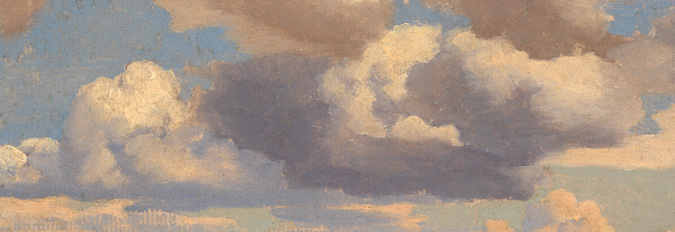Technical notes
Oil on paper, laid down on canvas, 22.3 -22.8 x 34.0 cm (visible surface). Signed lower left: COROT. (fig.1)

Support
The paper weave is prominent and affects the paint structure in the left part of the sky, where ridges are visible. The paper is mounted onto canvas, which is stretched on a rigid strainer, suggesting that the mounting was done soon after the picture was made. Robaut notes that almost all of Corot's early Italian views were painted on paper and were subsequently mounted: '…they were badly stuck onto poor quality canvases fitted with poor stretchers or executed on sorry panels, and what is more by lending them to hundreds of colleagues and friends, the master let them come and go all his life, the result being that many of them had suffered very badly.'1 It is quite possible that NG 3285 was one of those lent by Corot.
Materials and technique2
There are some traces of rudimentary drawing, possibly done with crayon, especially in the architecture and where the hills meet the skyline, visible in infra-red (fig. 2). There is no drawing in the foreground. The ground is lead white; above this the whole has been painted in one single layer of paint, swiftly and confidently brushed. Working with a small range of colours, greens, beiges and purple/violet and blues for the land, and blues, purples and whites for the sky, Corot has perfectly captured an extensive sunlit landscape under a blue sky studded with bright clouds.

The foreground is a light grey-beige, almost white in appearance. Behind there is a strip of mid-green with a row of small trees or bushes. The country then extends towards the aqueduct and tower. The hills in the distance are rendered in violet and blue. Corot has left reserves for elements in the composition, such as the green bush on the right. The hills are brought around the aqueducts on left and right. In the sky the clouds were painted first, with the sky brought around them.
The pigments used are conventional for the period, including vermilion, cobalt blue in the sky and lead white in the clouds. However, there is one notable exception, viridian, which is present, for the most part mixed with earth colours, in the green in the foreground, in the mid-green strip on the left-hand side, in the dull green foliage of the right-hand side, and in the black of the bush on the right-hand side.
Viridian is the English name for hydrated (that is, transparent) chromium oxide, vert éméraude in French, thought until comparatively recently to have been available to artists only from the 1830s. Chromium oxide, an opaque green, was discovered by the French chemist Louis Nicolas Vauquelin in 1797 and used in porcelain factories. In 1798, however, Vauquelin also described a green colour produced by heating the newly discovered chromium metal with a blowpipe and borax, which may have been chemically similar to hydrated chromium oxide pigment.3
Antoine-Claude Pannetier (1772–1859), an artist-chemist and friend and pupil of Girodet, was the first to manufacture the pigment, keeping the process secret. Church gives the date of 1838 for Pannetier’s discovery, which has been repeated by every author on the subject since.4 Charles-Ernest Guignet patented a method for producing the pigment in 1859.5
However, Louis-Charles Arsenne refers to viridian in his Manuel du Peintre et du Sculpteur of 1833, stating that it was available from the colourmen Colcomb-Bourgeois.6 He writes: 'This last colour marries perfectly well with browns and gives the greens a very intense tone. When it is known it will be of great use to the landscapist.'7 It was extremely expensive at this time but price does not seem to have been a disincentive to Corot, as by 1821 he was in receipt of a yearly income of 1,500 livres.8
Corot was already a customer at Colcomb-Bourgeois when he first went to Italy in 1825, and on 29 October 1826 wrote to his friend Abel Osmond for colours from the firm.9 The evidence from this painting suggests that Pannetier had placed his pigment with these colourmen as early as the 1820s, and that Arsenne subsequently wrote about it in his manual of 1833.
Related to this early use of viridian is the further question of whether Corot preferred to mix his greens rather than use ready-made ones, and in much of the recent technical literature on Corot it has been asserted that he preferred to use a mixture of blue and yellow. Robaut is again the source for this theory: 'When he saw the master on the 22nd of September 73 he observed once again that he didn’t use a single green or viridian; and when I asked him the reason he told me that these ready-made greens irritated him, that they are harsh, that he preferred making them in his own manner, sienna earth and burnt sienna with cobalt or yellow ochre with Prussian blue or mineral blue, yellow cadmium with ochre lake and all the tones in-between without thinking about it or formula decided upon in advance.'10
However, not only did Corot use ready-made greens he used them extremely early in his career. Viridian has also been found in a painting from Corot’s second trip to Italy, View of Riva of 1835 (Munich, Neue Pinakothek), where he has mixed it with cobalt blue.11 The crucial point is that in both the Munich painting and NG 3285 Corot has tempered the colour to mitigate its harsh tone.12
Analysis of the binding media has revealed heat-bodied linseed, poppyseed and walnut oils with the minor addition of pine resin, mastic resin (in the green impasto of the bank) and pinaceae resin, possibly fir balsam. The resin would have been incorporated into the paint in the form of varnish, which Corot presumably added on his palette as he worked.
Conservation and condition
NG 3285 was cleaned by the Gallery in 1965.The condition is good. The top right corner of the paper is folded and a small section is lost and there is a small diagonal tear in the upper right edge. What may be pin marks are visible in the two corners on the left side, the corners on the right side are too damaged for such to be found.

